MENU
MENU
Tea production area: Kamikatsu Town, Naka Town, Minami Town, Miyoshi City, Kaiyo Town
Brand: Awa bancha, Kamikatsu bancha, Jidencha, Aioi bancha, Boke tea
Types of tea: Dark tea (post-fermentation tea), sencha (medium steamed green tea), genmaicha (steamed green tea with roasted rice), kukicha (steamed green tea with stems), black tea, etc.
Awa bancha
Awa bancha is a post-fermented tea made with lactic acid bacteria. Awa bancha is made in Kamikatsu Town, Naga Town and Minami Town. Each region has brand names, such as Kamikatsu bancha, Jidencha, etc.
The origin of Awa bancha is unknown, but there are a few local traditions. One is that a Buddhist monk Kukai introduced the production method of Awa bancha from Tang (China) where he studied Chinese Buddhism in the 9th century.
In 2018, Awa bancha, Goishicha, and Ishizuchikuro-cha were designated as “recordable folk cultural property” for their fermented tea producing technology in the Shikoku Region and in 2021, the production method of Awa bancha was designated an Important Intangible Folk Cultural Property of Japan.
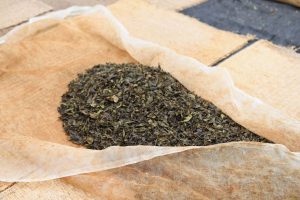
Jidencha at Takeichi-noen, Kamikatsu Town (August 2019)
The method of producing Awa bancha
1. In July tea leaves are hand-picked by stripping them from branches.
2. The tea leaves are boiled in a large caldron within 3 days of being picked. After being boiled, the leaves are rolled by a tea rolling machine. The rolling machine used for Awa bancha is shaped like a wooden boat.
3. The rolled leaves are put in a wooden bucket and covered with a wooden lid. Heavy stones are placed on the wooden lid and the tea is kept there for about 2 weeks in order to create a lactic fermentation.
4. The leaves then dried on a straw mat in the sun or in a green house.
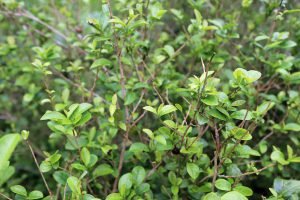
Tea plants at Takeichi-noen, Kamikatsu Town (August 2019)
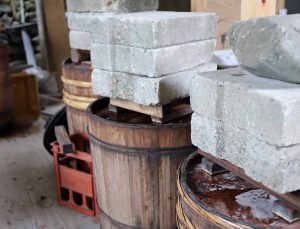
Tea leaves fermenting in a wooden bucket at Takeichi-noen, Kamikatsu Town (August 2019)
According to the local people, the method for making Awa bancha is by brewing the tea leaves in a kyusu (teapot) in the same way as sencha and not by boiling it in water with a pan.
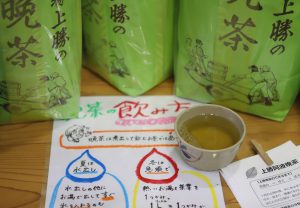
Kamikatsu Awa bancha at Ikkyuchaya (August 2019)
During fermentation, the tea leaves in the wooden bucket will produce a unique fermented odor. Finished tea leaves and the brewed tea has a fruity aroma with a sour and sharp flavor.
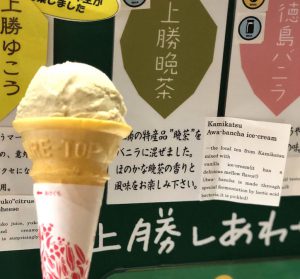
Kamikatsu bancha ice cream at Ikkyuchaya (August 2019)
Sencha and kamairicha (pan-fired green tea) are made in Naga Town.
Sencha is made in Miyoshi City and it called Boke tea.
Kancha is made in Kaiyo Town. Kancha is a sun-dried bancha produced in the winter. The production method of kancha is simple. It is done by steaming and drying the tea leaves.
Bancha (番茶・晩茶):
Originally bancha means coarse tea in contrast with sencha (medium-steamed green tea). Sencha is produced with new tender tea leaves which plucked in the first tea season in Japan. Bancha is produced with matured hard tea leaves and stems plucked in the late season of the first tea season or in autumn. Shuto bancha means steamed green tea produced with tea leaves plucked in the autumn and early winter.
Additionally, bancha is used for the local special tea, such as Sado bancha of Nigata Prefecture, Mimasaka bancha of Okayama Prefecture, Awa bancha of Tokushima Prefecture, Kyo bancha of Kyoto Prefecture, etc., but each producing method is different.
Related article on the site:
Tea related facility: いっきゅう茶屋 http://www.ikkyuu-chaya.com
Tea mascot Yuru-Chara:
Ceramic and pottery art:
Reference:
松下智 (平成3年) 日本名茶紀行 (初版) 雄山閣出版
高野實・谷本陽蔵・富田勲・中川致之・岩浅潔・寺本益英・山田新市 (2005) 緑茶の事典 (改訂3版) 柴田書店
大森正司、阿南豊正、伊勢村護、加藤みゆき、滝口明子、中村羊一郎編(2017) 茶の事典 初版第一刷 朝倉書店
徳島県「阿波晩茶製造技術」調査報告書
国選択記録作成等の措置を構ずべき無形の民俗文化財
四国山地の発酵茶の製造技術「阿波晩茶製造技術」調査報告書 令和二年三月徳島県 総論P22
https://www.pref.tokushima.lg.jp
https://www.pref.tokushima.lg.jp/ippannokata/kyoiku/bunka/5037140
上勝町 ふるさと名物
www.kamikatsu.jp/docs/2019032500011/file_contents/kamikatsu_furusato.pdf
那賀町 相生晩茶
www.town.tokushima-naka.lg.jp/gyosei/docs/3604.html
那賀町 観光物産紹介木頭茶(釜煎り茶)
https://www.town.tokushima-naka.lg.jp/gyosei/docs/3662.html
三好やまびこふるさと会 歩危(ぼけ)銘茶 大歩危(おぼけいや)
http://www.miyoshi-yamabiko.jp/?pid=35806217
海陽町観光協会 道の駅「宍喰温泉」物産コーナーで海陽朝の寒茶を購入することができます。
https://kaiyo-kankou.jp/index.php/25-gdaa/series/152.html
文化庁 報道発表 平成30年1月19日 文化審議会答申(重要無形民俗文化財の指定等)
https://www.bunka.go.jp/
https://www.bunka.go.jp/koho_hodo_oshirase/hodohappyo/__icsFiles/afieldfile/2018/01/18/a1400149_01.pdf
文化庁 報道発表令和3年1月15日文化審議会答申(重要有形民俗文化財の指定等)
https://www.bunka.go.jp
https://www.bunka.go.jp/koho_hodo_oshirase/hodohappyo/pdf/92776001_02.pdf
*When visiting the shops and facilities introduced in this article, please check the business hours on their website, etc. before visiting.
*The information provided on this site may be updated. If you find any information in this article that is incorrect, new, or incomplete, please contact CHAMART.
*The site does not describe all “Teas of Japan” or all “Teas of the World”. Additionally, each article expresses the writer’s personal experience and feelings.
#awabancha #tokushima